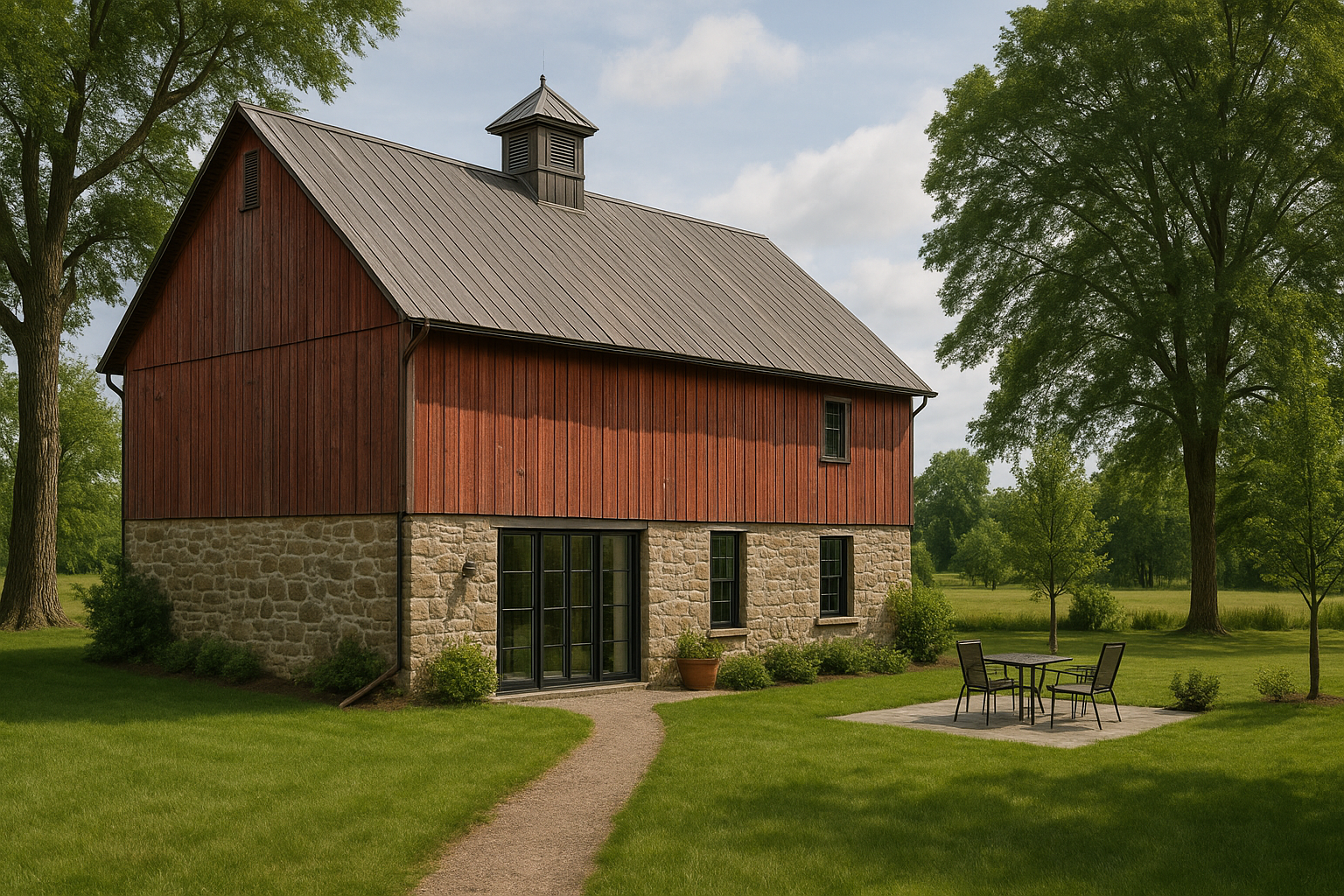
Barn Conversions: How to Transform Heritage Barns into Rural ADUs While Respecting Historic Preservation and Canadian Regulations
Estimated reading time: 8 minutes
Key Takeaways
- Adaptive Reuse: Transform heritage barns into functional ADUs while retaining historic charm.
- Modern Upgrades: Integrate modern amenities and energy-saving features without compromising original design.
- Compliance: Adhere to Canadian building codes, zoning laws, and heritage regulations to ensure a seamless conversion.
- Sustainability: Embrace sustainable practices by utilizing reclaimed materials and eco-friendly upgrades.
- Expert Collaboration: Involve structural engineers and heritage consultants early in the process for a successful transformation.
Table of contents
- Understanding Barn Conversions in the Rural ADU Context
- The Importance of Historic Preservation in Adaptive Reuse
- Navigating Canadian Regulations for Rural ADUs
- Steps to Successfully Convert a Heritage Barn
- Challenges and Solutions in Barn Conversions
- Case Studies: Barn Conversions, Historic Preservation, and Canadian Regulations
- Conclusion: Embracing Barn Conversions for Rural ADUs in Canada
- Frequently Asked Questions
Understanding Barn Conversions in the Rural ADU Context
Barn conversions refer to the adaptive reuse of old agricultural barns into new, livable spaces such as ADUs. In rural Canada, this trend honors the legacy of heritage barns by transforming them into multi-functional layouts ideal for extended family living, guest houses, or rental income.
Key aspects include:
- High ceilings and exposed beams that enhance spatial character.
- Tranquil rural settings that offer privacy and a strong connection to nature.
- The preservation of rustic features like stonework and timber framing.
- Adaptive strategies that balance heritage with modern functionality.
For additional insights, refer to this resource and this discussion.
The Importance of Historic Preservation in Adaptive Reuse
Preserving heritage means maintaining the distinctive features—like original timber frames, hand-built stone walls, and antique barn doors—that tell the story of the past, even as the structure is updated for modern use.
Why Preserve?
- Cultural Heritage: Links to Canada’s agricultural history and rural identity.
- Aesthetic Value: Salvaged materials and craftsmanship add beauty and sustainability.
- Economic Benefit: Well-preserved features can enhance property value and appeal.
Employ strategies such as restoring original elements, carefully upgrading features, and documenting changes. Learn more at this detailed guide and this expert insight.
Navigating Canadian Regulations for Rural ADUs
Every barn conversion must conform to Canadian regulatory standards—covering building codes, zoning laws, and heritage designations—to ensure safety and legal compliance.
Regulatory Considerations:
- Building Codes: Requirements include fire safety, accessibility, and climate readiness, particularly for larger structures.
- Zoning Laws: Verify if converting a barn into an ADU is permitted within your municipal and provincial guidelines.
- Heritage Designations: Properties listed as historic may require additional approvals from local heritage boards.
For further details, check out this update on code changes, this comprehensive guide, and this Ontario permit guide.
Steps to Successfully Convert a Heritage Barn
Converting a barn into a rural ADU involves thorough planning and precise execution. Here are the essential steps:
1. Initial Assessment: Barn Conversions and Historic Preservation
Begin by evaluating the barn’s structure and historical significance:
- Structural Inspection: Engage a structural engineer to assess risks like weak foundations or deteriorating timbers.
- Historical Evaluation: Document and photograph original features to inform future restoration.
More information can be found here and here.
2. Design Planning: Adaptive Reuse for Rural ADUs
Develop a detailed design plan that marries modern amenities with historic features.
- Modern Amenities: Plan for essential upgrades like plumbing, heating, and electrical systems.
- Heritage Features: Ensure that strategic elements such as exposed beams and original stone are highlighted.
- Visualization: Utilize sketches and digital models to fine-tune the design while securing stakeholder approvals.
Explore additional resources at this article and this guide.
3. Adaptive Reuse Techniques and Historic Preservation
Implement techniques that balance modern needs with preserved character:
- Material Repurposing: Reuse old lumber and barn doors as design features.
- Open-Plan Living: Maximize space by embracing wide, flexible interiors.
- Subtle Modernization: Conceal modern installations (like ductwork) behind reclaimed panels.
Additional details can be referenced here and here.
4. Material Choices and Sustainability
Selecting the right materials is key:
- Reclaimed & Local: Utilize original barn wood and locally sourced stone to maintain authenticity.
- Eco-Friendly Upgrades: Install energy-efficient windows, high-efficiency HVAC systems, and modern insulation that respect the barn’s character.
- Sustainability: Consider renewable energy options like solar panels if permitted.
For more insights, visit this resource, this discussion, and this energy efficiency guide.
Challenges and Solutions in Barn Conversions
While barn conversions are rewarding, they are not without challenges:
Common Challenges:
- Structural Weakness: Older barns may require significant reinforcement or foundation upgrades.
- Regulatory Hurdles: Navigating multiple layers of building codes, zoning laws, and heritage approvals can be complex.
- Preservation Conflicts: Balancing modern improvements with historic features may sometimes result in design challenges.
Practical Solutions:
- Involve experts early—structural engineers and heritage consultants can streamline the process.
- Maintain regular communication with municipal and heritage authorities to adjust plans as needed.
- Adopt flexible design approaches that highlight essential features while permitting necessary modernizations.
Discover more at this update and this resource.
Case Studies: Barn Conversions, Historic Preservation, and Canadian Regulations
Consider the hypothetical example of an Ontario Heritage Barn Guest House:
A family transformed a century-old stone and timber barn into a rental ADU while retaining its rustic charm. They conducted a thorough assessment, preserved key features, and integrated modern systems—all under the vigilant eye of municipal and heritage boards.
- Assessment: Structural evaluations confirmed safe timber frames while identifying areas for moisture protection.
- Design: An open layout with lofted bedrooms, repurposed barn doors, and modern amenities maintained the barn’s character.
- Approval: Compliance with zoning and heritage requirements was achieved through detailed digital plans and early consultations.
This case study illustrates the successful blend of historical reverence and modern functionality. For further reading, visit this detailed account and this analysis.
Conclusion: Embracing Barn Conversions for Rural ADUs in Canada
Barn conversions represent an exciting opportunity to merge history with modern living. They not only unlock the unique architectural charm of rural barns but also provide innovative housing solutions for extended families, rentals, and sustainable living.
Remember:
- The demand for rural ADUs is increasing as homeowners value both heritage and modernity.
- Preserving original features is key to maintaining cultural and aesthetic appeal.
- Compliance with Canadian regulations is essential—early expert consultation can save time and avoid delays.
Ready to start your barn conversion? Begin your research, consult with local planning and heritage experts, and transform your heritage barn into a unique rural ADU.
Learn more at this guide, this resource, and this analysis.
Frequently Asked Questions
Q1: What exactly is a barn conversion?
A: Barn conversion is the process of transforming an old agricultural barn into a modern living space, such as an ADU, while preserving its historical elements.
Q2: How do I ensure compliance with Canadian regulations?
A: Begin by consulting local authorities, hiring experts in building codes and heritage conservation, and obtaining all necessary permits before starting your project.
Q3: Can modern conveniences be added without affecting a barn’s historic charm?
A: Yes, through careful design and adaptive reuse techniques, modern amenities can be discreetly integrated while preserving key historic features.

Leave a Reply